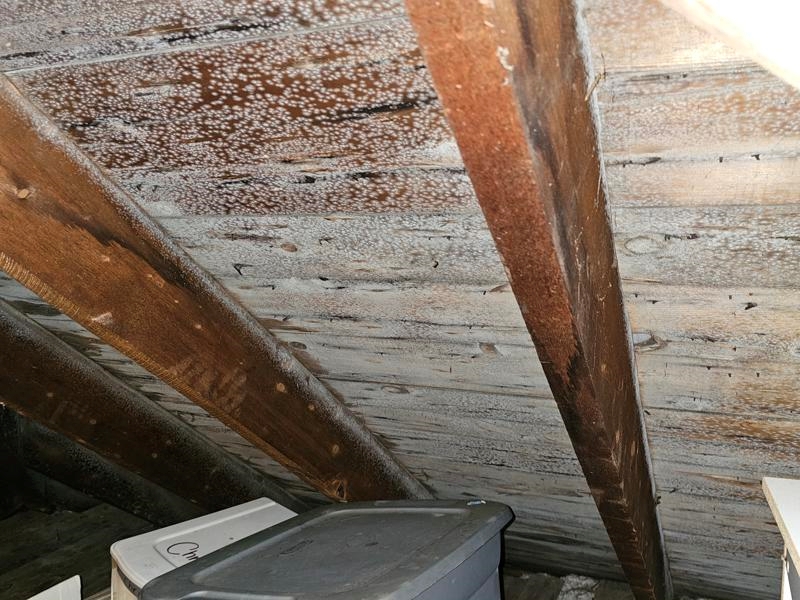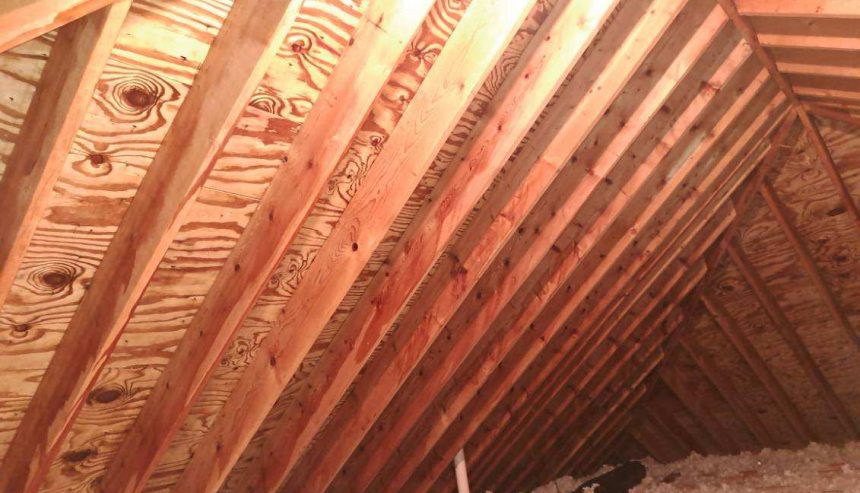Mold is a prevalent issue that can impact any household, particularly in regions with high humidity such as New Hampshire and Southern Maine. Mold needs an organic food source and moisture supply to grow and can inflict significant damage to your property when the conditions allow. All homes have “settled” mold spores on every surface in the home but need a food source and moisture supply to grow and cause problems. It’s worth noting that one of the areas where mold can proliferate unnoticed is your attic.
What Does Attic Mold Look Like?
Before you can take action, you need to recognize what you’re actually dealing with — and mold in the attic is often mistaken for something else. Many homeowners believe what they’re seeing is just dirt, dust, or water staining. But attic mold has some clear visual indicators:
- White mold may appear as fuzzy or powdery patches, often spreading along wood sheathing or rafters.
- Black mold can look like spotty discoloration, dark streaks, or blotchy staining, often near areas of trapped moisture or poor ventilation.
- You may also notice musty smells, peeling insulation, or dark areas near nails, vents, or ridge beams.
🎥 Want to see what real attic mold looks like?
Watch our quick walkthrough video:
In this video, Tyson from PuroClean of Strafford County walks through a real attic inspection, pointing out visible mold growth and explaining what makes it different from typical dirt or age-related staining.
Knowing what mold looks like can help you act quickly — and avoid wasting time on ineffective DIY solutions.
At PuroClean of Strafford County, we use a three step process in the mold remediation process for attic spaces. This includes
- Hepa vacuuming. We vacuum 100% of the exposed affected framing and surface area to remove additionally settled spores. This process physically removes all excessive mold spores in the space.
- Direct treatment with an anti-microbial solution. We use this to kill any remaining root systems
- Treatment with a mold stain removal product. This removes any residual staining and is cosmetic only.
When you are unsure if you have mold in your attic or any other places in your home, we would refer you to our partners at Green Air Solutions out of Portsmouth NH to provide comprehensive mold testing when mold identification is necessary. This would help kickstart the process of treating mold in your attic or any other place in your home.

However, if you find mold in your attic, don’t panic. Here are some steps you can take to deal with it safely and effectively.
- Identify the source of moisture. Mold needs moisture to grow, so there must be a source of water or humidity in your attic that is feeding the mold. Some possible sources are roof leaks, plumbing leaks, condensation from HVAC systems, poor ventilation, or inadequate insulation. You can use a moisture meter to check the moisture level of different areas in your attic and look for signs of water damage, such as stains, discoloration, or warping.
- Fix the moisture problem. Once you have identified the source of moisture, you need to fix it as soon as possible to prevent further mold growth and damage. Depending on the severity and complexity of the problem, you may need to hire a professional contractor or roofer to repair the leak or improve the ventilation or insulation in your attic. Make sure to dry out any wet materials thoroughly after fixing the moisture problem.
- Remove the moldy materials. If the mold has affected porous materials, such as cardboard, upholstered goods, or other organic materials, you may need to remove and replace them entirely, as they cannot be cleaned effectively. You should wear protective gear, such as gloves, goggles, and a respirator, when handling moldy materials and seal them in plastic bags before disposing of them. You should also isolate the affected area from the rest of your home to prevent cross-contamination.
- Clean the non-porous surfaces. If the mold has affected non-porous surfaces, such as metal, plastic, or glass, you can clean them with a solution of water and detergent. You should scrub the surfaces with a stiff brush or sponge and rinse them with clean water. You should also disinfect the surfaces with a fungicide or an antimicrobial spray to kill any remaining mold spores. Remember you are cleaning the organic dust from the non-porous surface which will help prevent it from returning.
- Monitor the situation. After cleaning and drying your attic, you should monitor it regularly for any signs of mold recurrence. You should also check the moisture level and ventilation in your attic and make sure they are within acceptable ranges. If you notice any mold growth or smell any musty odors, you should repeat the cleaning process or contact a professional mold remediation company.

If you need help with mold removal in your attic or any other part of your home or business in New Hampshire or Southern Maine, you can trust PuroClean of Strafford County to provide you with fast, reliable, and compassionate service. PuroClean of Strafford County is a locally owned and operated company with huge experience in home restoration and damage mitigation. We are certified by IICRC and EPA and use state-of-the-art equipment and techniques to restore your property to its pre-loss condition. We are available 24/7 for any emergency situation and work with all insurance companies to make the process as smooth as possible for you.
Contact us today at (603) 664-3727 or visit our website for more information.
Frequently Asked Questions About Attic Mold
What does attic mold look like?
Attic mold often appears as white, fuzzy patches or black spots, streaks, or blotches on wood surfaces. It usually forms near roof leaks, vents, nails, or anywhere moisture has been trapped. Many homeowners mistake it for dirt or dust, but mold has a distinct texture and growth pattern that signals a moisture problem.
What does mold in the attic look like?
Mold in the attic typically shows up as black blotches, dark streaks, or powdery white growth on wood sheathing and rafters. It follows areas where moisture collects, such as near vents, under leaks, or around poorly sealed openings.
Can mold in the attic make you sick?
Yes, attic mold can affect indoor air quality if spores spread into living areas. This can trigger allergies, asthma symptoms, or other respiratory issues, especially in homes with poor ventilation or sealing.
How do you treat attic mold?
Proper attic mold treatment starts with stopping the moisture source — such as repairing leaks or improving ventilation. PuroClean uses HEPA vacuums, EPA-registered antimicrobial solutions, and sealing or encapsulation where necessary to prevent future growth. DIY approaches like using bleach are not effective for long-term remediation.
What causes mold in the attic?
Mold in attics is caused by moisture buildup from roof leaks, ice dams, blocked or improper ventilation, or bathroom exhaust fans venting directly into the attic instead of outside.
Is attic mold dangerous?
Yes. Attic mold can damage wood, insulation, and other structural elements over time. It can also contribute to poor air quality, making it important to address promptly.
Should I buy a house with mold in the attic?
A home with attic mold isn’t necessarily a dealbreaker, but it should be professionally evaluated. Understanding the cause, extent of the problem, and remediation costs will help you make an informed decision.
How do you clean attic mold?
Cleaning attic mold requires more than surface wiping. The process includes HEPA vacuuming, antimicrobial treatments, and sealing affected areas. It’s critical to address the moisture source to prevent regrowth.
What should you spray on attic mold?
Spraying alone won’t solve an attic mold problem. PuroClean uses EPA-approved antimicrobial treatments as part of a complete remediation process that includes cleaning, drying, and moisture control.
Need attic mold help? Call PuroClean of Strafford County at 603-664-3727 or visit puroclean.com/psc-nh.



